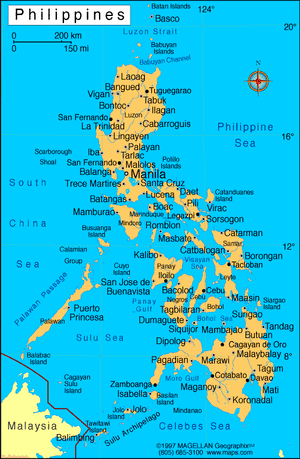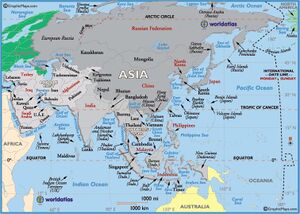Philippines
| Author: Laxman Burdak, IFS (R). |
Philippines is a unitary sovereign and archipelagic country in Southeast Asia. The capital city of the Philippines is Manila.
Origin of name
The Philippines was named in honor of King Philip II of Spain.
Location
Situated in the western Pacific Ocean, it consists of about 7,641 islands[1] that are categorized broadly under three main geographical divisions from north to south: Luzon, Visayas, and Mindanao.
Bounded by the South China Sea on the west, the Philippine Sea on the east and the Celebes Sea on the southwest, the Philippines shares maritime borders with Taiwan to the north, Vietnam to the west, Palau to the east and Malaysia and Indonesia to the south.
History
Prehistory: Recent discovery of stone tools and fossils of butchered animal remains in Rizal, Kalinga has pushed back evidence of early hominins in the archipelago to as early as 709,000 years.[2] However, the metatarsal of the Callao Man, reliably dated by uranium-series dating to 67,000 years ago remains the oldest human remnant found in the archipelago to date.[3] This distinction previously belonged to the Tabon Man of Palawan, carbon-dated to around 26,500 years ago.[4][5] Negritos were also among the archipelago's earliest inhabitants, but their first settlement in the Philippines has not been reliably dated.</ref>[6]
There are several opposing theories regarding the origins of ancient Filipinos. F. Landa Jocano theorizes that the ancestors of the Filipinos evolved locally. Wilhelm Solheim's Island Origin Theory[7] postulates that the peopling of the archipelago transpired via trade networks originating in the Sundaland area around 48,000 to 5000 BC rather than by wide-scale migration. The Austronesian Expansion Theory explains that Malayo-Polynesians coming from Taiwan began migrating to the Philippines around 4000 BC, displacing earlier arrivals.[8]
The most widely accepted theory, based on linguistic and archeological evidence, is the "Out-of-Taiwan" model, which hypothesizes that Austronesians from Taiwan, who were themselves descended from the neolithic civilizations of the Yangtze river such as the Liangzhu culture,[9] began migrating to the Philippines around 4000 BC, displacing earlier arrivals.[10] During the neolithic period, a "jade culture" is said to have existed as evidenced by tens of thousands of exquisitely crafted jade artifacts found in the Philippines dated to 2000 BC.[11]
The jade is said to have originated nearby in Taiwan and is also found in many other areas in insular and mainland Southeast Asia. These artifacts are said to be evidence of long range communication between prehistoric Southeast Asian societies.[12] By 1000 BC, the inhabitants of the archipelago had developed into four kinds of social groups: hunter-gatherer tribes, warrior societies, highland plutocracies, and port principalities.[13]
Precolonial epoch: The current demarcation between the Prehistory and the Early history of the Philippines is 21 April 900, which is the equivalent on the Proleptic Gregorian calendar for the date indicated on the Laguna Copperplate Inscription—the earliest known surviving written record to come from the Philippines.[14] This date came in the middle of what anthropologists refer to as the Philippines' "Emergent Phase" (1st–14th centuries CE), which was characterized by newly emerging socio-cultural patterns, the initial development of large coastal settlements, greater social stratification and specialization, and the beginnings of local and international trade.[15]
By the 1300s, a number of the large coastal settlements had become progressive trading centers, and became the focal point of societal changes, ushering complex lifeways which characterized what F. Landa Jocano called the "Barangic Phase" of early Philippine history, beginning from the 14th century through the arrival of Spanish colonizers and the beginning of the Philippines' colonial period.[16]
The discovery of iron at around the 1st century AD created significant social and economic changes which allowed settlements to grow larger and develop new social patterns, characterized by social stratification and specialization.[17]
Some of these polities, particularly the coastal settlements at or near the mouths of large rivers,[18] eventually developed substantial trade contacts with the early trading powers of Southeast Asia, most importantly the Indianized kingdoms of Malaysia and Java, the various dynasties of China,[19] Thailand,[20] and later, the Muslim Sultanate of Brunei.[21] They also traded with Vietnam, Japan, and other Austronesian islands.
Based on archeological findings, trade with China is believed to have begun in the Tang dynasty, but grew more extensive during the Song dynasty.[22] By the 2nd millennium CE, some (but not all) Philippine polities were known to have sent trade delegations which participated in the Tributary system enforced by the Chinese imperial court. These "tributary states" nominally acknowledged the Sinocentric system which saw China and the imperial court as the cultural center of the world. Among the early Philippine polities, this arrangement fulfilled the requirements for trade with China, but did not actually translate into political or military control. [23]
The Ifugao/Igorot people utilized terrace farming in the steep mountainous regions of northern Philippines over 2000 years ago.
Regarding the relations of early Philippine polities with the various state-level polities of Indonesia and Malaysia, legendary accounts often mention the interaction of early Philippine polities with the Srivijaya empire, but there is not much archeological evidence to definitively support such a relationship.[24] Considerable evidence exists, on the other hand, for extensive trade with the Majapahit empire.[25]
The exact scope and mechanisms of Indian cultural influences on early Philippine polities are still the subject of some debate among Southeast Asian historiographers,[26][27]
Indian cultural traits, such as linguistic terms and religious practices,[28] filtered in during the 10th through the early 14th centuries, through early Philippine polities' relations with the Hindu Majapahit empire.[29] The Philippine archipelago is thus one of the countries, (others include Afghanistan and Southern Vietnam) just at the outer edge of what is considered the "Greater Indian cultural zone".[30]
Modern History: The arrival of Ferdinand Magellan, a Portuguese explorer leading a fleet for the Spanish, in Homonhon, Eastern Samar in 1521 marked the beginning of Hispanic colonization. In 1543, Spanish explorer Ruy López de Villalobos named the archipelago Las Islas Filipinas in honor of Philip II of Spain. With the arrival of Miguel López de Legazpi from Mexico City, in 1565, the first Hispanic settlement in the archipelago was established.[31] The Philippines became part of the Spanish Empire for more than 300 years. This resulted in Catholicism becoming the dominant religion. During this time, Manila became the western hub of the trans-Pacific trade connecting Asia with Acapulco in the Americas using Manila galleons.[32]
Jat History
Hukum Singh Panwar (Pauria)[33] writes....India must have a a great significance in the dispersion of Blood Group-B in Central and Middle Asia, Europe and the Eastern Asiatic countries. North and north Western India and Pakistan where B is highest are believed to be predominantly inhabited by Aryan speaking races or branches of the White race. B is thought to be in India for millennia by the anthropologists. While describing the Jats of north western India Mr. M.G. Srinath[34] believes them, on the bases of their morphological characters, to be of the,
The Jats:Their Origin, Antiquity and Migrations: End of p.119
Caucasian stock (White or Nordic) and confirms that higher incidence of B than A among the Indians (37.2 in Jats App. no.2) is attributed to the natural selection acting over 4000 years. 'A' 'B' came first and 'O' arose later by mutation-(?)
B is believed to have reached Africa through Western India; and eastward to the Malay Archipelago and farther east[35]. B spread from Central Asia and India through Indonesia to Philippines along with Hindu influence as late as the first millennium A.D. and filtrated into Europe, and still later with oriental trade"[36].
References
- ↑ "More islands, more fun in PH". CNN Philippines. February 20, 2016.
- ↑ Earliest known hominin activity in the Philippines by 709 thousand years ago
- ↑ Henderson, Barney (August 4, 2010). "Archaeologists unearth 67000-year-old human bone in Philippines". The Daily Telegraph. London.
- ↑ Fox, Robert B. (1970). The Tabon Caves: Archaeological Explorations and Excavations on Palawan. National Museum. p. 44. ASIN B001O7GGNI.
- ↑ Scott, William Henry (1984). Prehispanic Source Materials for the Study of Philippine History. Quezon City: New Day Publishers. p. 15. ISBN 971-10-0227-2.
- ↑ Scott, William Henry (1984). Prehispanic Source Materials for the Study of Philippine History. Quezon City: New Day Publishers. p. 15. ISBN 971-10-0227-2.
- ↑ Solheim, Wilhelm G., II. (2006). Archeology and Culture in Southeast Asia. University of the Philippines Press. pp. 57–139. ISBN 978-971-542-508-7.
- ↑ Mijares, Armand Salvador B. (2006). The Early Austronesian Migration To Luzon: Perspectives From The Peñablanca Cave Sites. Bulletin of the Indo-Pacific Prehistory Association 26: 72–78. (archived from the original on July 7, 2014)
- ↑ Bellwood, Peter (2014). The Global Prehistory of Human Migration. p. 213.
- ↑ Mijares, Armand Salvador B. (2006). The Early Austronesian Migration To Luzon: Perspectives From The Peñablanca Cave Sites. Bulletin of the Indo-Pacific Prehistory Association 26: 72–78. (archived from the original on July 7, 2014)
- ↑ Scott, William (1984). Prehispanic Source Material. p. 17.
- ↑ Hsiao-Chun, Hung (2007). Ancient jades map 3,000 years of prehistoric exchange in Southeast Asia.
- ↑ Legarda, Benito, Jr. (2001). "Cultural Landmarks and their Interactions with Economic Factors in the Second Millennium in the Philippines". Kinaadman (Wisdom) A Journal of the Southern Philippines. 23: 40.
- ↑ Postma, Antoon (1992). "The Laguna Copper-Plate Inscription: Text and Commentary". Philippine Studies. Ateneo de Manila University. 40 (2): 182–203.
- ↑ ocano, F. Landa (2001). Filipino Prehistory: Rediscovering Precolonial Heritage. Quezon City: Punlad Research House, Inc. ISBN 971-622-006-5.
- ↑ ocano, F. Landa (2001). Filipino Prehistory: Rediscovering Precolonial Heritage. Quezon City: Punlad Research House, Inc. ISBN 971-622-006-5.
- ↑ ocano, F. Landa (2001). Filipino Prehistory: Rediscovering Precolonial Heritage. Quezon City: Punlad Research House, Inc. ISBN 971-622-006-5.
- ↑ Junker, L (1999). Raiding, Trading, and Feasting the Political Economy of Philippine Chiefdoms. Honolulu: University of Hawaiì Press.
- ↑ Junker, L (1999). Raiding, Trading, and Feasting the Political Economy of Philippine Chiefdoms. Honolulu: University of Hawaiì Press.
- ↑ Miksic, John N. (2009). Southeast Asian Ceramics: New Light on Old Pottery. Editions Didier Millet. ISBN 9789814260138.
- ↑ Scott, William Henry (1994). Barangay: Sixteenth Century Philippine Culture and Society. Quezon City: Ateneo de Manila University Press
- ↑ Scott, William Henry (1994). Barangay: Sixteenth Century Philippine Culture and Society. Quezon City: Ateneo de Manila University Press
- ↑ Scott, William Henry (1994). Barangay: Sixteenth Century Philippine Culture and Society. Quezon City: Ateneo de Manila University Press
- ↑ Jocano, F. Landa (2001). Filipino Prehistory: Rediscovering Precolonial Heritage. Quezon City: Punlad Research House, Inc. ISBN 971-622-006-5.
- ↑ Jocano, Felipe Jr. (2012-08-07). Wiley, Mark, ed. A Question of Origins. Arnis: Reflections on the History and Development of Filipino Martial Arts. Tuttle Publishing. ISBN 978-1-4629-0742-7.
- ↑ Jocano, F. Landa (2001). Filipino Prehistory: Rediscovering Precolonial Heritage. Quezon City: Punlad Research House, Inc. ISBN 971-622-006-5.
- ↑ Osborne, Milton (2004). Southeast Asia: An Introductory History (Ninth ed.). Australia: Allen & Unwin. ISBN 1-74114-448-5.
- ↑ Jocano, Felipe Jr. (2012-08-07). Wiley, Mark, ed. A Question of Origins. Arnis: Reflections on the History and Development of Filipino Martial Arts. Tuttle Publishing. ISBN 978-1-4629-0742-7.
- ↑ Jocano, F. Landa (2001). Filipino Prehistory: Rediscovering Precolonial Heritage. Quezon City: Punlad Research House, Inc. ISBN 971-622-006-5.
- ↑ Osborne, Milton (2004). Southeast Asia: An Introductory History (Ninth ed.). Australia: Allen & Unwin. ISBN 1-74114-448-5.
- ↑ "History of Cebu". Cebu City Tour.
- ↑ Kane, Herb Kawainui (1996). "The Manila Galleons". In Bob Dye. Hawaiʻ Chronicles: Island History from the Pages of Honolulu Magazine. I. Honolulu: University of Hawaii Press. pp. 25–32. ISBN 0-8248-1829-6.
- ↑ The Jats:Their Origin, Antiquity and Migrations/An Historico-Somatometrical study bearing on the origin of the Jats, p.119-120
- ↑ Srinath, M.G., "Jats of Caucasian Stock"? in the Hindustan Times, April 6, 1984.
- ↑ Ency. America, No. 28, p. 107. about 100,00 Indians (probable of Jat tribe of Mann) migrated to Vietnam in prehistoric times. (within brackets mine)
- ↑ Howells, W.W., Mankind So Far, N. York, 1945; p. 98.

